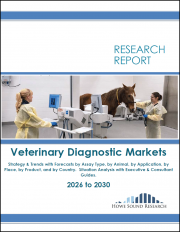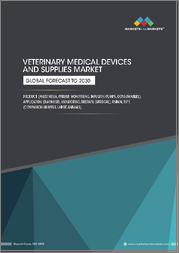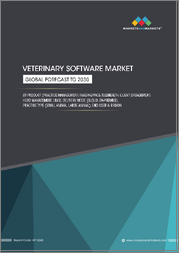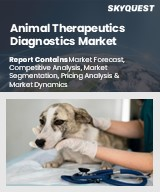
|
시장보고서
상품코드
1621610
세계의 동물용 장비 및 용품 시장 : 유형별, 동물 유형별, 용도별, 최종 사용자별 - 예측(2025-2030년)Veterinary Equipment & Supplies Market by Type (Anesthesia Equipment, Critical Care Consumables, Fluid Management Equipment), Animal Type (Large Animals, Small Companion Animals), Application, End-User - Global Forecast 2025-2030 |
||||||
동물용 장비 및 용품 시장은 2023년에 23억 2,000만 달러로 평가되었습니다. 2024년에는 24억 8,000만 달러에 이를 것으로 예측되며 CAGR 7.10%로 성장해 2030년에는 37억 5,000만 달러에 이를 것으로 예측됩니다.
동물용 장비 및 용품 시장에는 수술 장비, 진단 도구, 소모품 등 동물의 진단, 모니터링, 치료에 사용되는 다양한 제품이 포함됩니다. 이 시장을 주도하는 것은 전 세계 반려동물 사육 인구 증가와 동물 건강에 대한 인식 증가입니다. 동물 전염병 및 동물 복지를 위한 규제 지원과 같은 요인에 의해 촉발된 고급 수의학 서비스에 대한 수요로 인해 필요성이 발생합니다. 용도는 동물병원, 병원, 연구기관에 이르기까지 다양하며, 최종 용도는 반려동물과 농장동물 모두에 적용됩니다. 주요 성장 요인으로는 동물용 장비의 기술 발전, 연구 개발 활동의 활성화, 동물 의료비 증가에 기여하는 반려동물 보험 동향 등을 들 수 있습니다.
| 주요 시장 통계 | |
|---|---|
| 기준 연도(2023년) | 23억 2,000만 달러 |
| 예측 연도(2024년) | 24억 8,000만 달러 |
| 예측 연도(2030년) | 37억 5,000만 달러 |
| CAGR(%) | 7.10% |
큰 비즈니스 기회는 편의성과 치료 효과를 높이는 스마트 커넥티드 동물용 기기 개발에 있습니다. 또한, 이국적이고 흔하지 않은 반려동물을 위한 서비스를 확대하는 것도 성장의 길을 제시합니다. 그러나 첨단 동물용 의료기기와 관련된 높은 비용으로 인해 신흥국 시장에서의 보급이 제한적이라는 과제도 남아있습니다. 규제 장벽은 신기술의 승인 및 채택 과정을 지연시키는 요인이 되기도 합니다. 또한, 일부 지역에서는 숙련된 수의사 부족으로 인해 서비스 제공에 어려움을 겪고 있습니다.
신흥국 시장에 대응하기 위해 수의학 원격의료 플랫폼, 진료 관리에 IoT 통합, 비용 효율적인 휴대용 진단 솔루션 개발 등의 분야에서 혁신을 촉진할 수 있습니다. 지속 가능하고 친환경적인 제품에 집중하는 것은 소비자 선호의 세계 트렌드와도 일치합니다. 시장 경쟁은 치열하지만 제품 기능의 혁신, 고객 지원 서비스 강화, 동물 의료 제공업체와의 전략적 제휴를 통해 차별화할 수 있는 여지가 있습니다. 경쟁 압력을 극복하기 위해 기업은 시장 조사에 투자하여 지역적 특수성, 고객 니즈 및 경쟁 구도를 이해해야 합니다. 또한, 수의과대학 및 전문 기관과의 제휴는 새로운 트렌드와 기술에 대한 발판이 되어 진화하는 시장 환경 속에서 지속적인 성장과 관련성을 보장할 수 있습니다.
시장 역학: 빠르게 진화하는 동물용 장비 및 용품 시장의 주요 시장 인사이트 공개
동물용 장비 및 용품 시장은 수요 및 공급의 역동적인 상호작용에 의해 변화하고 있습니다. 이러한 시장 역학의 변화를 이해함으로써 기업은 정보에 입각한 투자 결정을 내리고, 전략적인 의사결정을 정교화하며, 새로운 비즈니스 기회를 포착할 수 있습니다. 이러한 트렌드를 종합적으로 파악함으로써 기업은 정치적, 지리적, 기술적, 사회적, 경제적 영역 전반에 걸친 다양한 리스크를 줄일 수 있으며, 소비자 행동과 그것이 제조 비용 및 구매 동향에 미치는 영향을 보다 명확하게 이해할 수 있습니다.
- 시장 성장 촉진요인
- 반려동물 및 가축 사육 수 증가
- 동물의 만성질환 및 우발적 상해 발생률 상승
- 세계 각국의 동물 의료 시설 개선
- 시장 성장 억제요인
- 동물용 장비 및 소모품 관련 높은 비용
- 시장 기회
- 동물용 장비 및 용품의 기술 진보
- 동물용 의료기기의 현대화를 위한 막대한 투자
- 시장 과제
- 숙련된 수의사 부족과 동물용 장비의 기술적 문제
Porter's Five Forces: 동물용 장비 및 용품 시장 탐색을 위한 전략 도구
Porter's Five Forces 프레임워크는 시장 상황경쟁 구도를 이해하는 중요한 도구입니다. Porter의 Five Forces 프레임워크는 기업의 경쟁력을 평가하고 전략적 기회를 탐색할 수 있는 명확한 방법을 제공합니다. 이 프레임워크는 기업이 시장 내 세력도를 평가하고 신규 사업의 수익성을 판단하는 데 도움이 됩니다. 이러한 통찰력을 통해 기업은 강점을 활용하고, 약점을 해결하고, 잠재적인 도전을 피하고, 보다 강력한 시장 포지셔닝을 확보할 수 있습니다.
PESTLE 분석 : 동물용 장비 및 용품 시장의 외부 영향 파악
외부 거시 환경 요인은 동물용 장비 및 용품 시장의 성과 역학을 형성하는 데 매우 중요한 역할을 합니다. 정치적, 경제적, 사회적, 기술적, 법적, 환경적 요인에 대한 분석은 이러한 영향을 탐색하는 데 필요한 정보를 제공하며, PESTLE 요인을 조사함으로써 기업은 잠재적 위험과 기회를 더 잘 이해할 수 있습니다. 이러한 분석을 통해 기업은 규제, 소비자 선호도, 경제 동향의 변화를 예측하고 선제적이고 능동적인 의사결정을 내릴 준비를 할 수 있습니다.
시장 점유율 분석 동물용 기기 및 용품 시장에서경쟁 구도 파악
동물용 장비 및 용품 시장의 상세한 시장 점유율 분석을 통해 공급업체의 성과를 종합적으로 평가할 수 있습니다. 기업은 수익, 고객 기반, 성장률과 같은 주요 지표를 비교하여 경쟁적 위치를 파악할 수 있습니다. 이 분석은 시장의 집중화, 단편화 및 통합 추세를 파악할 수 있으며, 공급업체는 치열한 경쟁 속에서 자신의 입지를 강화할 수 있는 전략적 의사결정을 내리는 데 필요한 통찰력을 얻을 수 있습니다.
FPNV 포지셔닝 매트릭스 동물용 장비 및 용품 시장에서공급업체 성과 평가
FPNV 포지셔닝 매트릭스는 동물용 장비 및 용품 시장에서 공급업체를 평가하는 중요한 도구입니다. 이 매트릭스를 통해 비즈니스 조직은 벤더의 비즈니스 전략과 제품 만족도를 기반으로 평가하여 목표에 부합하는 정보에 입각한 의사결정을 내릴 수 있으며, 4개의 사분면으로 벤더를 명확하고 정확하게 세분화하여 전략 목표에 가장 적합한 파트너와 솔루션을 식별할 수 있습니다. 전략 목표에 가장 적합한 파트너와 솔루션을 식별할 수 있습니다.
동물용 장비 및 용품 시장에서 성공하기 위한 전략 분석 및 권장 사항
동물용 장비 및 용품 시장의 전략적 분석은 세계 시장에서 입지를 강화하고자 하는 기업에게 필수적입니다. 주요 자원, 역량 및 성과 지표를 검토함으로써 기업은 성장 기회를 식별하고 개선할 수 있습니다. 이러한 접근 방식은 경쟁 환경의 도전을 극복하고 새로운 비즈니스 기회를 활용하여 장기적인 성공을 거둘 수 있는 체계를 구축할 수 있도록 도와줍니다.
이 보고서는 주요 관심 분야를 포괄하는 시장에 대한 종합적인 분석을 제공합니다.
1. 시장 침투도 : 현재 시장 환경의 상세한 검토, 주요 기업의 광범위한 데이터, 시장 도달 범위 및 전반적인 영향력 평가.
2. 시장 개척도: 신흥 시장에서의 성장 기회를 파악하고, 기존 분야의 확장 가능성을 평가하며, 미래 성장을 위한 전략적 로드맵을 제공합니다.
3. 시장 다각화 : 최근 제품 출시, 미개척 지역, 업계의 주요 발전, 시장을 형성하는 전략적 투자를 분석합니다.
4. 경쟁 평가 및 정보 : 경쟁 구도를 철저히 분석하여 시장 점유율, 사업 전략, 제품 포트폴리오, 인증, 규제 당국의 승인, 특허 동향, 주요 기업의 기술 발전 등을 검토합니다.
5. 제품 개발 및 혁신 : 미래 시장 성장을 가속할 것으로 예상되는 첨단 기술, 연구 개발 활동 및 제품 혁신을 강조합니다.
이해관계자들이 충분한 정보를 바탕으로 의사결정을 내릴 수 있도록 다음과 같은 중요한 질문에 대한 답변도 제공합니다.
1. 현재 시장 규모와 향후 성장 전망은?
2. 최고의 투자 기회를 제공하는 제품, 부문, 지역은?
3. 시장을 형성하는 주요 기술 동향과 규제의 영향은?
4. 주요 벤더의 시장 점유율과 경쟁 포지션은?
5.벤더 시장 진입 및 철수 전략의 원동력이 되는 수익원과 전략적 기회는 무엇인가?
목차
제1장 서문
제2장 조사 방법
제3장 주요 요약
제4장 시장 개요
제5장 시장 인사이트
- 시장 역학
- 성장 촉진요인
- 성장 억제요인
- 기회
- 과제
- 시장 세분화 분석
- Porter's Five Forces 분석
- PESTEL 분석
- 정치
- 경제
- 사회
- 기술
- 법률
- 환경
제6장 동물용 장비 및 용품 시장 : 유형별
- 마취 기기
- 중환자 치료 소모품
- 유체 관리 장비
- 환자 모니터링 장비
- 구조 및 소생 기기
- 연구 기기
- 체온 관리 기기
제7장 동물용 장비 및 용품 시장 : 동물 유형별
- 대형 동물
- 소형 반려동물
제8장 동물용 장비 및 용품 시장 : 용도별
- 진단/모니터링/치료
- 외과적 응용
제9장 동물용 장비 및 용품 시장 : 최종사용자별
- 수의 클리닉 및 병원
- 수의 학연 연구소
- 수의 연구기관
제10장 아메리카의 동물용 장비 및 용품 시장
- 아르헨티나
- 브라질
- 캐나다
- 멕시코
- 미국
제11장 아시아태평양의 동물용 장비 및 용품 시장
- 호주
- 중국
- 인도
- 인도네시아
- 일본
- 말레이시아
- 필리핀
- 싱가포르
- 한국
- 대만
- 태국
- 베트남
제12장 유럽, 중동 및 아프리카의 동물용 장비 및 용품 시장
- 덴마크
- 이집트
- 핀란드
- 프랑스
- 독일
- 이스라엘
- 이탈리아
- 네덜란드
- 나이지리아
- 노르웨이
- 폴란드
- 카타르
- 러시아
- 사우디아라비아
- 남아프리카공화국
- 스페인
- 스웨덴
- 스위스
- 터키
- 아랍에미리트(UAE)
- 영국
제13장 경쟁 구도
- 시장 점유율 분석, 2023년
- FPNV 포지셔닝 매트릭스, 2023년
- 경쟁 시나리오 분석
- 전략 분석과 제안
기업 리스트
- Advancis Veterinary Ltd.
- B. Braun SE
- Becton, Dickinson and Company
- Bionet America, Inc.
- Burtons Medical Equipment Ltd.
- Cardinal Health, Inc.
- Covetrus, Inc.
- Digicare Biomedical
- Dispomed Ltd.
- DRE Medical, Inc. by Avante Animal Health
- Eickmeyer
- Grady Medical Systems
- Integra LifeSciences Corporation
- J & J Instruments, Inc.
- Jorgensen Laboratories, LLC
- Masimo Corp.
- Midmark Corporation
- MILA International, Inc.
- Naugra Medical
- Neogen Corporation
- New Gen Medical Systems
- Nonin Medical, Inc.
- RWD Life Science Co., Ltd.
- Vetland Medical Sales & Services LLC
- Vetronic Services Ltd.
The Veterinary Equipment & Supplies Market was valued at USD 2.32 billion in 2023, expected to reach USD 2.48 billion in 2024, and is projected to grow at a CAGR of 7.10%, to USD 3.75 billion by 2030.
The veterinary equipment and supplies market encompasses a wide array of products used for diagnosing, monitoring, and treating animals, including surgical equipment, diagnostic tools, and consumables. This market is driven by the rising pet ownership globally, coupled with increasing awareness about animal health. Necessity arises from the demand for advanced veterinary services, fueled by factors such as zoonotic diseases and regulatory support for animal welfare. Applications span across veterinary clinics, hospitals, and research institutes, with end-use covering both companion and farm animals. Key growth factors include technological advancements in veterinary devices, increasing R&D activities, and the growing trend of pet insurance contributing to higher veterinary care expenditure.
| KEY MARKET STATISTICS | |
|---|---|
| Base Year [2023] | USD 2.32 billion |
| Estimated Year [2024] | USD 2.48 billion |
| Forecast Year [2030] | USD 3.75 billion |
| CAGR (%) | 7.10% |
A significant opportunity lies in the development of smart and connected veterinary devices, which enhance convenience and care effectiveness. Additionally, expanding services for exotic and less common pets presents another growth avenue. However, challenges persist with high costs associated with advanced veterinary equipment limiting market penetration in developing regions. Regulatory hurdles can also slow down the approval and adoption process of new technologies. Furthermore, a shortage of skilled veterinarians in certain regions impedes service delivery.
Innovation can be fostered in areas such as telemedicine platforms for veterinary care, the integration of IoT in practice management, and the development of cost-effective portable diagnostic solutions to serve emerging markets. Focusing on sustainable and environmentally friendly products will also align with global trends in consumer preferences. Despite being highly competitive, the market offers room for differentiation through innovation in product features, enhanced customer support services, and strategic partnerships with veterinary care providers. To navigate competitive pressures, companies should invest in market research to understand regional specificities, customer needs, and regulatory landscapes. Engaging in collaborations with veterinary schools and professional organizations can also provide a foothold in emerging trends and technologies, ensuring sustained growth and relevance in the evolving market landscape.
Market Dynamics: Unveiling Key Market Insights in the Rapidly Evolving Veterinary Equipment & Supplies Market
The Veterinary Equipment & Supplies Market is undergoing transformative changes driven by a dynamic interplay of supply and demand factors. Understanding these evolving market dynamics prepares business organizations to make informed investment decisions, refine strategic decisions, and seize new opportunities. By gaining a comprehensive view of these trends, business organizations can mitigate various risks across political, geographic, technical, social, and economic domains while also gaining a clearer understanding of consumer behavior and its impact on manufacturing costs and purchasing trends.
- Market Drivers
- Increasing number of companion animal and livestock ownership
- Rising incidence of chronic diseases and accidental injuries in animals
- Improving veterinary care facilities in economies worldwide
- Market Restraints
- High cost associated with veterinary equipment & disposables
- Market Opportunities
- Technological advancements in veterinary equipment & supplies
- Significant investments to modernize veterinary equipment
- Market Challenges
- Dearth of skilled veterinarians and technical issues in veterinary equipment
Porter's Five Forces: A Strategic Tool for Navigating the Veterinary Equipment & Supplies Market
Porter's five forces framework is a critical tool for understanding the competitive landscape of the Veterinary Equipment & Supplies Market. It offers business organizations with a clear methodology for evaluating their competitive positioning and exploring strategic opportunities. This framework helps businesses assess the power dynamics within the market and determine the profitability of new ventures. With these insights, business organizations can leverage their strengths, address weaknesses, and avoid potential challenges, ensuring a more resilient market positioning.
PESTLE Analysis: Navigating External Influences in the Veterinary Equipment & Supplies Market
External macro-environmental factors play a pivotal role in shaping the performance dynamics of the Veterinary Equipment & Supplies Market. Political, Economic, Social, Technological, Legal, and Environmental factors analysis provides the necessary information to navigate these influences. By examining PESTLE factors, businesses can better understand potential risks and opportunities. This analysis enables business organizations to anticipate changes in regulations, consumer preferences, and economic trends, ensuring they are prepared to make proactive, forward-thinking decisions.
Market Share Analysis: Understanding the Competitive Landscape in the Veterinary Equipment & Supplies Market
A detailed market share analysis in the Veterinary Equipment & Supplies Market provides a comprehensive assessment of vendors' performance. Companies can identify their competitive positioning by comparing key metrics, including revenue, customer base, and growth rates. This analysis highlights market concentration, fragmentation, and trends in consolidation, offering vendors the insights required to make strategic decisions that enhance their position in an increasingly competitive landscape.
FPNV Positioning Matrix: Evaluating Vendors' Performance in the Veterinary Equipment & Supplies Market
The Forefront, Pathfinder, Niche, Vital (FPNV) Positioning Matrix is a critical tool for evaluating vendors within the Veterinary Equipment & Supplies Market. This matrix enables business organizations to make well-informed decisions that align with their goals by assessing vendors based on their business strategy and product satisfaction. The four quadrants provide a clear and precise segmentation of vendors, helping users identify the right partners and solutions that best fit their strategic objectives.
Strategy Analysis & Recommendation: Charting a Path to Success in the Veterinary Equipment & Supplies Market
A strategic analysis of the Veterinary Equipment & Supplies Market is essential for businesses looking to strengthen their global market presence. By reviewing key resources, capabilities, and performance indicators, business organizations can identify growth opportunities and work toward improvement. This approach helps businesses navigate challenges in the competitive landscape and ensures they are well-positioned to capitalize on newer opportunities and drive long-term success.
Key Company Profiles
The report delves into recent significant developments in the Veterinary Equipment & Supplies Market, highlighting leading vendors and their innovative profiles. These include Advancis Veterinary Ltd., B. Braun SE, Becton, Dickinson and Company, Bionet America, Inc., Burtons Medical Equipment Ltd., Cardinal Health, Inc., Covetrus, Inc., Digicare Biomedical, Dispomed Ltd., DRE Medical, Inc. by Avante Animal Health, Eickmeyer, Grady Medical Systems, Integra LifeSciences Corporation, J & J Instruments, Inc., Jorgensen Laboratories, LLC, Masimo Corp., Midmark Corporation, MILA International, Inc., Naugra Medical, Neogen Corporation, New Gen Medical Systems, Nonin Medical, Inc., RWD Life Science Co., Ltd., Vetland Medical Sales & Services LLC, and Vetronic Services Ltd..
Market Segmentation & Coverage
This research report categorizes the Veterinary Equipment & Supplies Market to forecast the revenues and analyze trends in each of the following sub-markets:
- Based on Type, market is studied across Anesthesia Equipment, Critical Care Consumables, Fluid Management Equipment, Patient Monitoring Equipment, Rescue & Resuscitation Equipment, Research Equipment, and Temperature Management Equipment.
- Based on Animal Type, market is studied across Large Animals and Small Companion Animals.
- Based on Application, market is studied across Diagnosis, Monitoring & Therapy and Surgical Application.
- Based on End-User, market is studied across Veterinary Clinics & Hospitals, Veterinary Laboratories, and Veterinary Research Institutes.
- Based on Region, market is studied across Americas, Asia-Pacific, and Europe, Middle East & Africa. The Americas is further studied across Argentina, Brazil, Canada, Mexico, and United States. The United States is further studied across California, Florida, Illinois, New York, Ohio, Pennsylvania, and Texas. The Asia-Pacific is further studied across Australia, China, India, Indonesia, Japan, Malaysia, Philippines, Singapore, South Korea, Taiwan, Thailand, and Vietnam. The Europe, Middle East & Africa is further studied across Denmark, Egypt, Finland, France, Germany, Israel, Italy, Netherlands, Nigeria, Norway, Poland, Qatar, Russia, Saudi Arabia, South Africa, Spain, Sweden, Switzerland, Turkey, United Arab Emirates, and United Kingdom.
The report offers a comprehensive analysis of the market, covering key focus areas:
1. Market Penetration: A detailed review of the current market environment, including extensive data from top industry players, evaluating their market reach and overall influence.
2. Market Development: Identifies growth opportunities in emerging markets and assesses expansion potential in established sectors, providing a strategic roadmap for future growth.
3. Market Diversification: Analyzes recent product launches, untapped geographic regions, major industry advancements, and strategic investments reshaping the market.
4. Competitive Assessment & Intelligence: Provides a thorough analysis of the competitive landscape, examining market share, business strategies, product portfolios, certifications, regulatory approvals, patent trends, and technological advancements of key players.
5. Product Development & Innovation: Highlights cutting-edge technologies, R&D activities, and product innovations expected to drive future market growth.
The report also answers critical questions to aid stakeholders in making informed decisions:
1. What is the current market size, and what is the forecasted growth?
2. Which products, segments, and regions offer the best investment opportunities?
3. What are the key technology trends and regulatory influences shaping the market?
4. How do leading vendors rank in terms of market share and competitive positioning?
5. What revenue sources and strategic opportunities drive vendors' market entry or exit strategies?
Table of Contents
1. Preface
- 1.1. Objectives of the Study
- 1.2. Market Segmentation & Coverage
- 1.3. Years Considered for the Study
- 1.4. Currency & Pricing
- 1.5. Language
- 1.6. Stakeholders
2. Research Methodology
- 2.1. Define: Research Objective
- 2.2. Determine: Research Design
- 2.3. Prepare: Research Instrument
- 2.4. Collect: Data Source
- 2.5. Analyze: Data Interpretation
- 2.6. Formulate: Data Verification
- 2.7. Publish: Research Report
- 2.8. Repeat: Report Update
3. Executive Summary
4. Market Overview
5. Market Insights
- 5.1. Market Dynamics
- 5.1.1. Drivers
- 5.1.1.1. Increasing number of companion animal and livestock ownership
- 5.1.1.2. Rising incidence of chronic diseases and accidental injuries in animals
- 5.1.1.3. Improving veterinary care facilities in economies worldwide
- 5.1.2. Restraints
- 5.1.2.1. High cost associated with veterinary equipment & disposables
- 5.1.3. Opportunities
- 5.1.3.1. Technological advancements in veterinary equipment & supplies
- 5.1.3.2. Significant investments to modernize veterinary equipment
- 5.1.4. Challenges
- 5.1.4.1. Dearth of skilled veterinarians and technical issues in veterinary equipment
- 5.1.1. Drivers
- 5.2. Market Segmentation Analysis
- 5.2.1. Type: Increasing significance of critical care consumables for emergencies or daily use
- 5.2.2. Animal Type: Proliferating utilization of veterinary equipment & supplies in small companion animals
- 5.2.3. Application: Rising adoption of diagnostic, monitoring, and therapeutic devices owing to their wide applications
- 5.2.4. End-User: Evolving usage of veterinary equipment & supplies in veterinary clinics & hospitals
- 5.3. Porter's Five Forces Analysis
- 5.3.1. Threat of New Entrants
- 5.3.2. Threat of Substitutes
- 5.3.3. Bargaining Power of Customers
- 5.3.4. Bargaining Power of Suppliers
- 5.3.5. Industry Rivalry
- 5.4. PESTLE Analysis
- 5.4.1. Political
- 5.4.2. Economic
- 5.4.3. Social
- 5.4.4. Technological
- 5.4.5. Legal
- 5.4.6. Environmental
6. Veterinary Equipment & Supplies Market, by Type
- 6.1. Introduction
- 6.2. Anesthesia Equipment
- 6.3. Critical Care Consumables
- 6.4. Fluid Management Equipment
- 6.5. Patient Monitoring Equipment
- 6.6. Rescue & Resuscitation Equipment
- 6.7. Research Equipment
- 6.8. Temperature Management Equipment
7. Veterinary Equipment & Supplies Market, by Animal Type
- 7.1. Introduction
- 7.2. Large Animals
- 7.3. Small Companion Animals
8. Veterinary Equipment & Supplies Market, by Application
- 8.1. Introduction
- 8.2. Diagnosis, Monitoring & Therapy
- 8.3. Surgical Application
9. Veterinary Equipment & Supplies Market, by End-User
- 9.1. Introduction
- 9.2. Veterinary Clinics & Hospitals
- 9.3. Veterinary Laboratories
- 9.4. Veterinary Research Institutes
10. Americas Veterinary Equipment & Supplies Market
- 10.1. Introduction
- 10.2. Argentina
- 10.3. Brazil
- 10.4. Canada
- 10.5. Mexico
- 10.6. United States
11. Asia-Pacific Veterinary Equipment & Supplies Market
- 11.1. Introduction
- 11.2. Australia
- 11.3. China
- 11.4. India
- 11.5. Indonesia
- 11.6. Japan
- 11.7. Malaysia
- 11.8. Philippines
- 11.9. Singapore
- 11.10. South Korea
- 11.11. Taiwan
- 11.12. Thailand
- 11.13. Vietnam
12. Europe, Middle East & Africa Veterinary Equipment & Supplies Market
- 12.1. Introduction
- 12.2. Denmark
- 12.3. Egypt
- 12.4. Finland
- 12.5. France
- 12.6. Germany
- 12.7. Israel
- 12.8. Italy
- 12.9. Netherlands
- 12.10. Nigeria
- 12.11. Norway
- 12.12. Poland
- 12.13. Qatar
- 12.14. Russia
- 12.15. Saudi Arabia
- 12.16. South Africa
- 12.17. Spain
- 12.18. Sweden
- 12.19. Switzerland
- 12.20. Turkey
- 12.21. United Arab Emirates
- 12.22. United Kingdom
13. Competitive Landscape
- 13.1. Market Share Analysis, 2023
- 13.2. FPNV Positioning Matrix, 2023
- 13.3. Competitive Scenario Analysis
- 13.3.1. Canada and Manitoba Invest USD 2 Million to Enhance Capacity of Rural Veterinary Services Districts
- 13.3.2. Mars To Acquire Veterinary Equipment Firm Heska
- 13.3.3. Volition Signs Global Supply Agreement for Nu.Q Vet Cancer Test
- 13.4. Strategy Analysis & Recommendation
Companies Mentioned
- 1. Advancis Veterinary Ltd.
- 2. B. Braun SE
- 3. Becton, Dickinson and Company
- 4. Bionet America, Inc.
- 5. Burtons Medical Equipment Ltd.
- 6. Cardinal Health, Inc.
- 7. Covetrus, Inc.
- 8. Digicare Biomedical
- 9. Dispomed Ltd.
- 10. DRE Medical, Inc. by Avante Animal Health
- 11. Eickmeyer
- 12. Grady Medical Systems
- 13. Integra LifeSciences Corporation
- 14. J & J Instruments, Inc.
- 15. Jorgensen Laboratories, LLC
- 16. Masimo Corp.
- 17. Midmark Corporation
- 18. MILA International, Inc.
- 19. Naugra Medical
- 20. Neogen Corporation
- 21. New Gen Medical Systems
- 22. Nonin Medical, Inc.
- 23. RWD Life Science Co., Ltd.
- 24. Vetland Medical Sales & Services LLC
- 25. Vetronic Services Ltd.



















